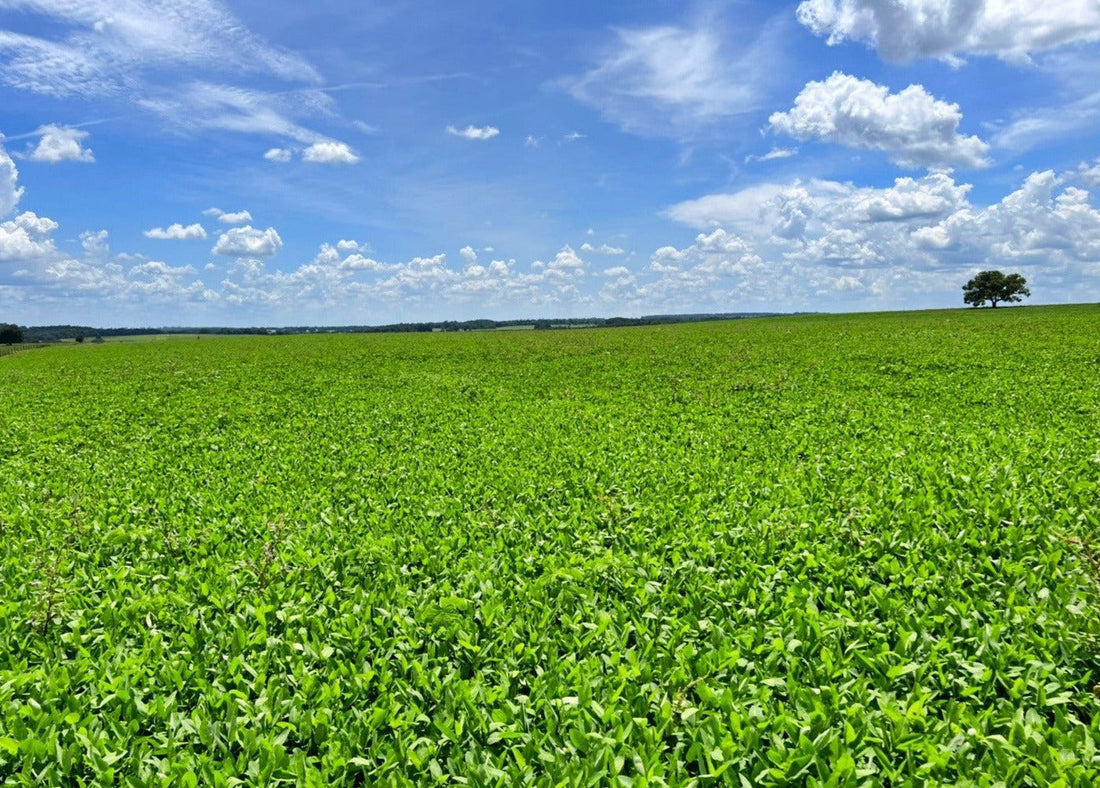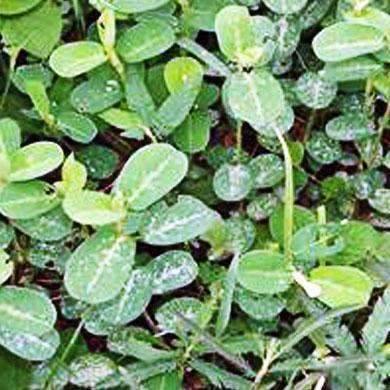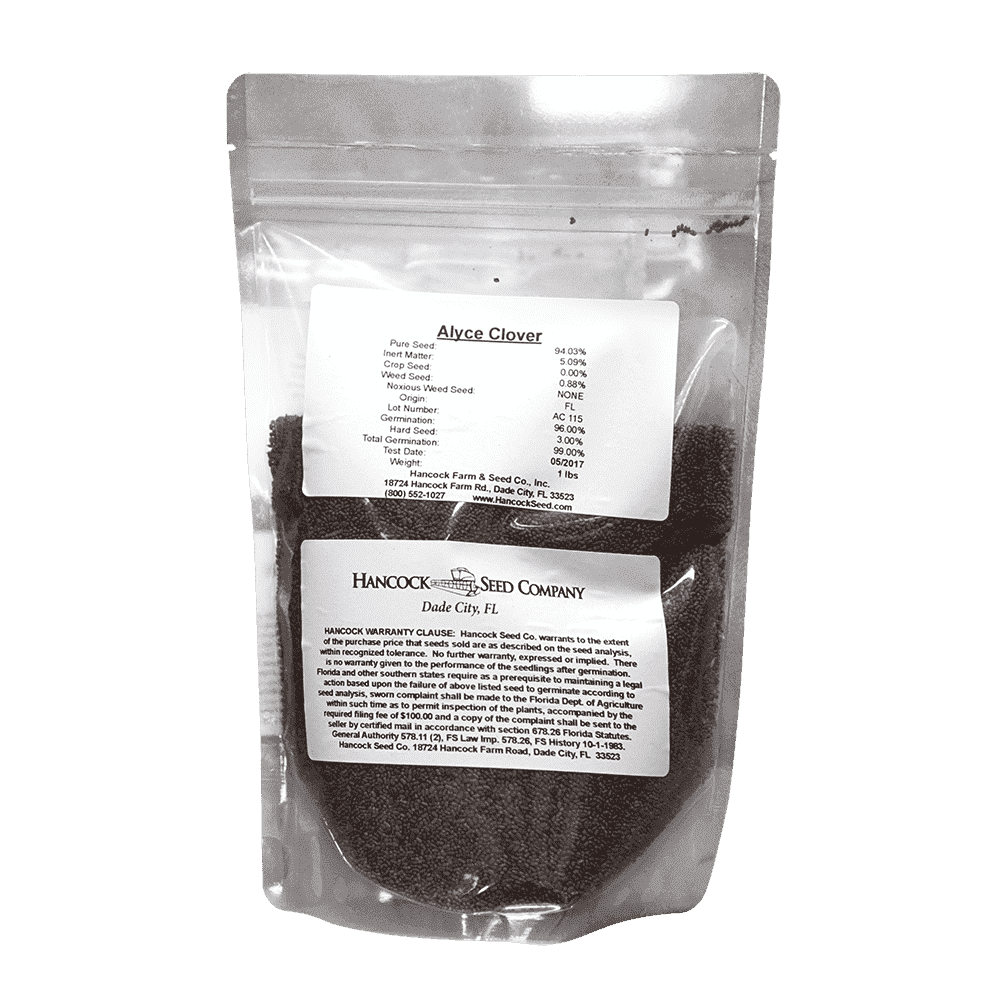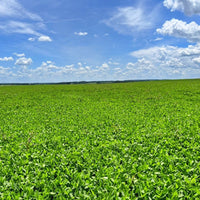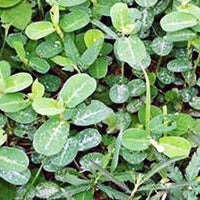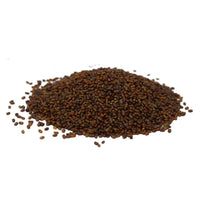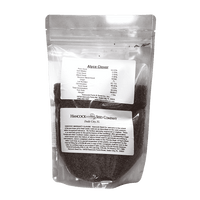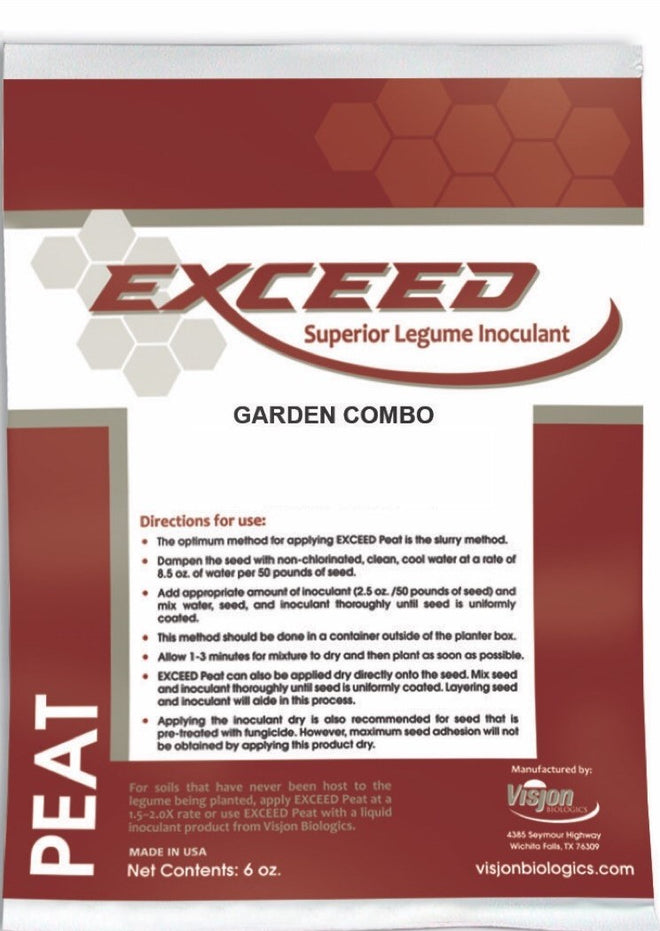
- When to plant:
- Spring, Summer
- Fertilizer:
- Hancock's 16-04-08 Lawn & Pasture Fertilizer
- Seeding rate:
- 20 - 25lbs. per acre
- Overseeding rate:
- 15lbs. per acre
- Seeding depth:
- 1/4 inch
- Ideal ph:
- 5.5 - 6.5
- Gmo:
- No
- Inoculant needed:
- No
- Coated or raw:
- Coated
- Lifecycle:
- Annual
- Climate zones:
- Cool Season, Transition Zone, Warm Season
Alyce Clover is a popular variety of "summer" clover for both those who are looking for a source of pasture feed for their livestock, or as a hunting plot. Working as the latter, Alyce Clover will attract deer, turkey, and quail. The Hancock family has been harvesting Alyce Clover in central Florida since the early 1930's.
Product Information
- Application or Use: Pasture, Food Plot, Hay Production, Cover Crop, Cattle Grazing
- Germination Time: 7 - 14, days, under optimal conditions
- Growing Locations: Warm Season, Transition Zone, Cool Season
- Height: 1 - 3 feet
- Sunlight Requirements: 6+ hours, full sun for best results
- Advantages: Popular variety for both those who are looking for a source of pasture feed for their livestock, or as a hunting plot; supplies key nutrients.
- When to Plant: Recommended planting time is spring and summer when nighttime temperatures are consistently above 65 degrees.
Product Information
- Annual summer sweet clover
- High protein legume
- Adapted to well-drained soils with good fertility
- Commonly used for forage, hay production, and wildlife food plots
- Provides essential nutrients for antler growth
Product Details
Alyce Clover will provide cover, and seed throughout the fall and early winter; it can be planted as early as the last chance of frost in the spring. If the seed pods reach maturity before the first frost, Alyce Clover will reseed. Alyce Clover does not perform well on soils that flood. Avoid sites with high levels of root-knot nematodes. These pests will attack common Alyce Clover and may severely damage the crop. Sites where Alyce Clover or other crops susceptible to root-knot nematodes have been grown in the previous season may have high levels of nematodes
*Product packaging may appear different than what is pictured.
Plant seed at a rate of 10 - 15 lbs. per acre during the Spring & Summer months Ensure that this seed is at a depth of 1/4 inch and has plenty of moisture for germination.
If winter rains have been below normal and soil moisture is low, then overseeding of a grass sod should be delayed until the summer rains begin in June. Use the high rate when the seedbed and soil condition are less favorable. The seed may be inoculated just prior to planting with N-fixing bacteria.
When planting into a grass sod that has been disked or chopped, the seed can be broadcast, followed by a harrow or drag of some type that will mix the seed with the soil, and then a cultipacker or roller may be useful to firm the soil. A good rain after broadcasting the seed will move the seed down and firm the soil, thus eliminating the need for harrowing and packing, but rainfall is unpredictable. When using a pasture drill, make sure the grass is cut or grazed short. When planting on a prepared seedbed, the seed are usually broadcast and covered with a cultipacker or planted with a grain drill. With either method, seed should be covered to a depth of 1/4 to 1/2". A well-prepared, level seedbed allows for planting at the right depth.
LIMING AND FERTILIZATION
Alyce Clover will not produce satisfactory growth on the very acid soils of low fertility. This crop requires a soil pH of 5.5 to 6.0. A soil test can be used to determine the need for lime, phosphorous, and potassium. If Alyce Clover is planted immediately following a highly fertilized crop, such as watermelons, it may not be necessary to add additional lime or fertilizer.
MANAGEMENT AND UTILIZATION
Alyce Clover makes good quality hay if the crop is harvested before it is overly mature and if it is dried and baled without significant leaf loss. Hay should be cut when plants are 18 to 24" tall. A second cutting of hay is possible under favorable growing conditions. In many cases, Alyce Clover is planted late and only one hay cutting is made. This harvest should be made when the crop begins to flower. The crop may vary in height from 10 in to 3 ft.
Alyce Clover planted early (April or May) will be tall enough for hay in mid to late August, but frequent rainfall may prevent harvesting at this time. Harvest can be delayed from 4 to 6 weeks without a severe loss in feeding value.
Alyce Clover can be grazed after the plants are about 12" tall. The animals should be removed after the plants are grazed down in order to permit regrowth. Overgrazing could allow weeds to invade the stand. The first growth may be grazed down and animals removed and regrowth used for hay or seed production. Alyce Clover can be used in a creep graze system for calves. Four-month-old calves have gained an additional 0.3 to 0.5 lb/day until they were weaned when Alyce Clover was available in a creep pasture.
Seed yields of up to 600 lbs. / acre may be obtained. Seed may be combined directly or the plants may be mowed, cured in the swath, and then threshed with a combine with a pick-up attachment. The latter method will usually result in a larger amount of seed being saved. Harvest of seed should begin when about 1/2 of the seed pods are brown. This will usually occur about mid-October.
When choosing to start a new lawn, remove old vegetation by using a de-thatcher, power rake or tiller to kill the existing vegetation. Rake or drag the area to remove debris and dead grass for a clean area. Ensure the soil is leveled and loosened to allow the seed to have good soil contact once spread on a clean seed bed.
If you have an area with heavy weed coverage, we recommend starting fresh by killing and removing the existing vegetation. If you choose to use chemicals, herbicides or fertilizers, you must check with the product's manufacturer prior to planting new seed to ensure the proper waiting period.
When overseeding an existing area, mow your lawn at the lowest setting and bag the clippingsx. Rake or drag any areas that have dead thatch or debris.

Seed Quality
Hancock Seed is dedicated to delivering the best seeds possible to our customers. Hancock Seed grows and harvests many of our products, and we acquire the majority of the rest from other family farmers.
All these seeds are processed, packaged and shipped from Hancock Farm. This helps us ensure that our high standards are met. Unlike much of the competition, we refuse to sell you a seed that was not gathered during the last harvest. You will always receive fresh product from Hancock.
Every seed we grow comes with 40 years of experience behind it...you can rest assured that all of our products are cultivated in a method that assures its potential for growth.

Your cart ( 0 )

Alyce Clover is a popular variety of "summer" clover for both those who are looking for a source of pasture feed for their livestock, or as a hunting plot. Working as the latter, Alyce Clover will attract deer, turkey, and quail. The Hancock family has been harvesting Alyce Clover in central Florida since the early 1930's.
Product Information
- Application or Use: Pasture, Food Plot, Hay Production, Cover Crop, Cattle Grazing
- Germination Time: 7 - 14, days, under optimal conditions
- Growing Locations: Warm Season, Transition Zone, Cool Season
- Height: 1 - 3 feet
- Sunlight Requirements: 6+ hours, full sun for best results
- Advantages: Popular variety for both those who are looking for a source of pasture feed for their livestock, or as a hunting plot; supplies key nutrients.
- When to Plant: Recommended planting time is spring and summer when nighttime temperatures are consistently above 65 degrees.
Product Information
- Annual summer sweet clover
- High protein legume
- Adapted to well-drained soils with good fertility
- Commonly used for forage, hay production, and wildlife food plots
- Provides essential nutrients for antler growth
Product Details
Alyce Clover will provide cover, and seed throughout the fall and early winter; it can be planted as early as the last chance of frost in the spring. If the seed pods reach maturity before the first frost, Alyce Clover will reseed. Alyce Clover does not perform well on soils that flood. Avoid sites with high levels of root-knot nematodes. These pests will attack common Alyce Clover and may severely damage the crop. Sites where Alyce Clover or other crops susceptible to root-knot nematodes have been grown in the previous season may have high levels of nematodes
*Product packaging may appear different than what is pictured.
Plant seed at a rate of 10 - 15 lbs. per acre during the Spring & Summer months Ensure that this seed is at a depth of 1/4 inch and has plenty of moisture for germination.
If winter rains have been below normal and soil moisture is low, then overseeding of a grass sod should be delayed until the summer rains begin in June. Use the high rate when the seedbed and soil condition are less favorable. The seed may be inoculated just prior to planting with N-fixing bacteria.
When planting into a grass sod that has been disked or chopped, the seed can be broadcast, followed by a harrow or drag of some type that will mix the seed with the soil, and then a cultipacker or roller may be useful to firm the soil. A good rain after broadcasting the seed will move the seed down and firm the soil, thus eliminating the need for harrowing and packing, but rainfall is unpredictable. When using a pasture drill, make sure the grass is cut or grazed short. When planting on a prepared seedbed, the seed are usually broadcast and covered with a cultipacker or planted with a grain drill. With either method, seed should be covered to a depth of 1/4 to 1/2". A well-prepared, level seedbed allows for planting at the right depth.
LIMING AND FERTILIZATION
Alyce Clover will not produce satisfactory growth on the very acid soils of low fertility. This crop requires a soil pH of 5.5 to 6.0. A soil test can be used to determine the need for lime, phosphorous, and potassium. If Alyce Clover is planted immediately following a highly fertilized crop, such as watermelons, it may not be necessary to add additional lime or fertilizer.
MANAGEMENT AND UTILIZATION
Alyce Clover makes good quality hay if the crop is harvested before it is overly mature and if it is dried and baled without significant leaf loss. Hay should be cut when plants are 18 to 24" tall. A second cutting of hay is possible under favorable growing conditions. In many cases, Alyce Clover is planted late and only one hay cutting is made. This harvest should be made when the crop begins to flower. The crop may vary in height from 10 in to 3 ft.
Alyce Clover planted early (April or May) will be tall enough for hay in mid to late August, but frequent rainfall may prevent harvesting at this time. Harvest can be delayed from 4 to 6 weeks without a severe loss in feeding value.
Alyce Clover can be grazed after the plants are about 12" tall. The animals should be removed after the plants are grazed down in order to permit regrowth. Overgrazing could allow weeds to invade the stand. The first growth may be grazed down and animals removed and regrowth used for hay or seed production. Alyce Clover can be used in a creep graze system for calves. Four-month-old calves have gained an additional 0.3 to 0.5 lb/day until they were weaned when Alyce Clover was available in a creep pasture.
Seed yields of up to 600 lbs. / acre may be obtained. Seed may be combined directly or the plants may be mowed, cured in the swath, and then threshed with a combine with a pick-up attachment. The latter method will usually result in a larger amount of seed being saved. Harvest of seed should begin when about 1/2 of the seed pods are brown. This will usually occur about mid-October.
Instructions
When choosing to start a new lawn, remove old vegetation by using a de-thatcher, power rake or tiller to kill the existing vegetation. Rake or drag the area to remove debris and dead grass for a clean area. Ensure the soil is leveled and loosened to allow the seed to have good soil contact once spread on a clean seed bed.
If you have an area with heavy weed coverage, we recommend starting fresh by killing and removing the existing vegetation. If you choose to use chemicals, herbicides or fertilizers, you must check with the product's manufacturer prior to planting new seed to ensure the proper waiting period.
When overseeding an existing area, mow your lawn at the lowest setting and bag the clippingsx. Rake or drag any areas that have dead thatch or debris.















